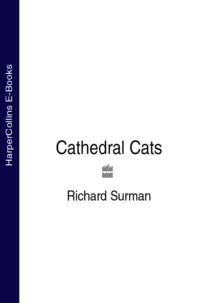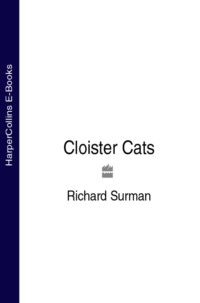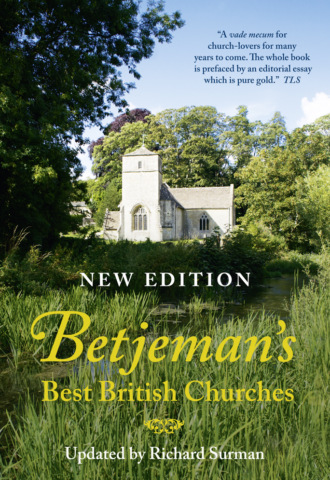
Полная версия
Betjeman’s Best British Churches
Heaven is represented in the chancel beyond the richly-painted screen, where the priest murmurs scarcely audible Latin and where the Body of Our Lord under the form of bread, hangs above the altar in a shrouded pyx. Much chatting goes on in the church during sermon and Mass, and we may now approach the screen to examine it and the jewel-like blazing richness beyond, in the holiest part of the church.
Through the screen which runs across the whole width of the church, you may glimpse the richest part of all this teaching imagery. The altars at the end of the aisles are either guild chapels, or family chapels, each with their paid priests. The Shoemakers may have an altar dedicated to Crispin, and will subscribe for its upkeep and to keep its lights burning. Another chapel may be kept up by a guild which pays a priest to say Mass for the Souls of its departed members. The secular descendants of these guilds are the trade unions and burial societies of today. The big town churches such as those at Coventry, Stamford and Bristol had many guild chapels with priests maintained to serve them. And many altars contained a relic of a saint. The walls round the altars were painted, the roofs above them were richer and more elaborately painted than those in the people’s part of the church, the altar hangings were of the richest silks and threaded with jewels, the fair linen-cloth laid upon the altar itself a white, plain contrast with the elaborate hangings. The floors of the chancel are of marble or tiles. Brasses of dead priests shone bright among them. You may see what they looked like in illuminated missals. The ornaments on the altar were few, candles perhaps, and if a cross, then a small one to help the priest in his devotions – for here in the chancel we meet the risen Lord. Only in the nave is He dead on the cross, as large as life.
Few people will make their communion at Mass. Indeed it is rare for anyone to make his communion except at Easter. People think of the Mass as something offered for them rather than something of which they partake the sacred elements.
On a hot summer Sunday morning in the country, when I have been reading Chaucer to the sound of bells pouring through the trees, I have been able dimly to imagine this late medieval religion. Life is short for everybody. It is matter of fact. The pictures on the church walls are not thought of as ‘art’, but are there to tell a story. Small parish churches were not consciously made beautiful. They were built and decorated for effect, to be better than the church in the next village, to be the best building in the village itself, for it is the House of God, and God become Man – that was the great discovery – offered here upon the altar. All sorts of miraculous stories were invented about Him, and even more about His mother. Because He was Man born of woman, he becomes within the grasp of everyone. Few of the extravagances of German and Spanish late medieval art are found in English representations of the scourging, the crucifixion and the deposition. Jesus is thought of as the baby of poor people who received the tributes of a king. His mother is the most beautiful woman in the world – and how many lovely, loving faces of Our Lady we may see in the old glass, wall-paintings and statues which survive in England. And she bore a Spotless Son who was God and Judge of all. No wonder she was loved by the pious English.
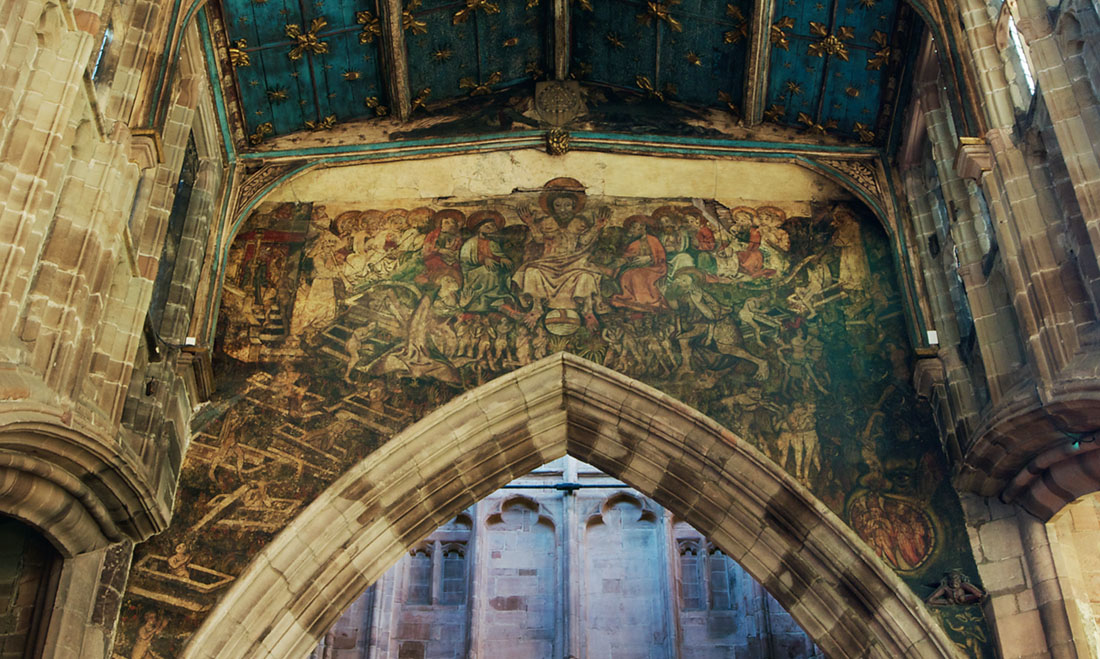
COVENTRY: HOLY TRINITY – only rediscovered in 1999 and now restored, this extraordinarily intact Doom painting is dated to the early 15th century
© Michael Ellis
The miracles of Our Lord were not so interesting to these people as the miracles they ascribed to His saints. Here extravagancy knew no bounds. St Petroc sailed in a silver bowl from Cornwall to an isle in the Indian Ocean. St Winifred was beheaded by an angry lover, but her head was reunited to her body and she became an abbess. There were saints like St Quintin who cured dropsy, saints for toothache, and for colds and fever, and for finding things. There were patron saints for every craft and trade. There were miraculous images which winked, or flew to bedsides; there were statues of saints that had never been, like the Maid Uncumber in old St Paul’s Cathedral.
Though for the everyday things of life there were friendly saints who helped, life itself must have been terrifying, a continual rush to escape hell. Our Lord and His Mother were the loving and human part of it; hell was the terrifying part. The Devil was seen. His fellow devils yawned as gargoyles with bats’ wings on the north walls of the church, black against the evening sky. The white teeth of devils and their red eyes gleamed out of the darkness. Evil spirits lurked behind stones on lonely moors and ranged the deep woods. Good and evil fought together in the roar of the storm. All thought, all sight, every breath of the body, was under God. The leaping sciapod, the man-eating mantichora, the unicorn, might easily be met in the forest by men with imaginations, which as easily would expect to see Our Lady flying through the air, or the local saint, for centuries enshrined in his altar, walking down the street. The witch cast her evil spells, blood and death lay around everywhere, the entrails of a man hung, drawn and quartered, shone black with flies in the sun, silvery lepers tinkled their bells, creating loneliness around them. The fear that men felt is expressed in the grotesque carvings over the north walls of churches, and in the corbels and bosses of roofs, and in bench-ends, screens and miserere stalls. Their humour is shewn there too. Chiefly in the figure of Our Lady do we see the tenderness and sweetness of this late religion.
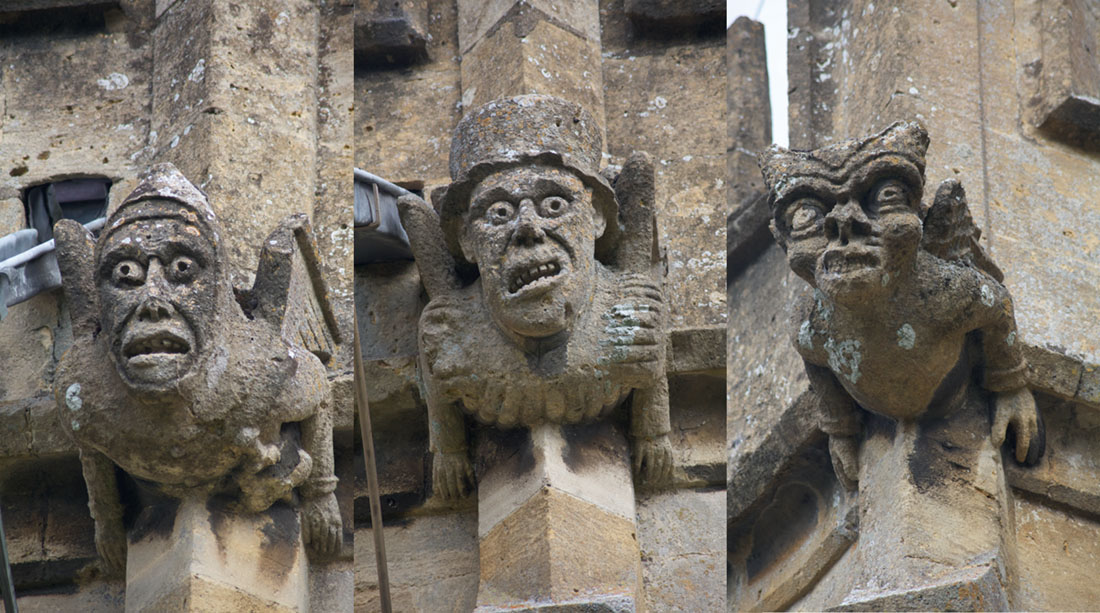
WINCHCOMBE: ST PETER – the church has a fascinating array of grotesques and gargoyles that seem to mix anguish, fear and broad comedy
© Michael Ellis
So when we walk down a green lane like an ancient cart track towards the ringing church-bells, we can see the power of God in the blossom and trees, remember legends of the saints about birds and stones, and recall miracles that happened in the parish at this or that spot. And on a feast day we can see the churchyard set out with tables for the church ale when Mass is over, and as we enter the nave we can see it thronged below the painted roof and walls with people in the village, young and old, and the rest of the parish crowding in with us. Human nature may not have been better. Life was as full, no doubt, of wrong and terror as it is today. How different it was is expressed in the words of Froude:
‘For, indeed, a change was coming upon the world, the meaning and direction of which even still is hidden from us, a change from era to era. The paths trodden by the footsteps of ages were broken up; old things were passing away and the faith and the life of ten centuries were dissolving like a dream. Chivalry was dying; the abbey and the castle were soon together to crumble into ruins; and all the forms, desires, beliefs, convictions of the old world were passing away never to return. A new continent had risen up beyond the western sea. The floor of heaven, inlaid with stars, had sunk back into an infinite abyss of immeasurable space; and the firm earth itself, unfixed from its foundations, was seen to be but a small atom in the awful vastness of the universe. In the fabric of habit which they had so laboriously built for themselves, mankind were to remain no longer.
And now it is all gone – like an unsubstantial pageant faded; and between us and the old English there lies a gulf of mystery which the prose of the historian will never adequately bridge. They cannot come to us, and our imagination can but feebly penetrate to them. Only among the sleeping on their tombs, some faint conceptions float before us of what these men were when they were alive; and perhaps in the sound of church bells, that peculiar creation of medieval age, which falls upon the ear like the echo of a vanished world.’
The Churches Before The Fifteenth Century
To imagine our church in earliest times of Christian England is, alas, to enter the controversial world of archaeology. There was a Christian Church in the Roman settlement at Silchester, Berkshire, and its remains have been excavated. It had an apse at the west end instead of the east where one would expect it to be, and the altar which is supposed to have been wooden and square, was also in the west. The east end was square. The church is said to be 4th century. Only the foundations remain. The form of worship was probably more like that of the Orthodox church today than the western rite.
But there are enough later pre-Conquest churches remaining to give us an idea of the architecture of those times. They are called Saxon. There are two types. The southern, of which the earliest churches are found in Kent – three in Canterbury, St Mary Lyminge, Reculver, and, most complete, Bradwell, Essex, all of which are 7th century – were the result of the Italian mission of St Augustine, and were reinforced after the coming of St Theodore in 669. In plan and style they resembled certain early Italian churches. The northern group found in Northumberland and Durham are survivals of the Celtic church, and their architecture is said to have come from Gaul, and is more barbaric looking than that of their southern contemporaries. Their three distinctive features were, according to Sir Arthur Clapham, an unusual length of nave, a small chancel, less wide than the nave, and very high side walls. In the northern group, the most complete is Escombe, Durham (7th and early 8th century?), a stern building, nave and chancel only, with squared rubble walls, small windows high up and square or round headed, and a narrow and tall rounded chancel arch. We have a picture of the interiors of these northern churches from near contemporary accounts. The walls and capitals and arch of the sanctuary were adorned ‘with designs and images and many sculptured figures in relief on the stone and pictures with a pleasing variety of colours and a wonderful charm’. We learn, too, of purple hangings and gold and silver ornaments with precious stones. Elsewhere in England the most considerable remains of pre-Conquest work are those at Monkwearmouth (Durham), Jarrow (Durham), Brixworth (Northants), Deerhurst (Glos), Bradford-on-Avon (Wilts), the tower of Earls Barton (Northants), Barton-on-Humber (Lincs), Sompting (Sussex), the Crypts at Repton (Derby), Wing (Bucks), and Hexham (Northumberland). From the pre-Conquest sculpture, like the crosses at Bewcastle and Ruthwell, and the carvings at Langford (Oxon), Romsey (Hants), Bexhill (Sussex), St Dunstan’s Stepney (London), and the moving relief of the Harrowing of Hell in Bristol Cathedral, and from such enrichment as survives in such objects as St Cuthbert’s stole (Durham), the Alfred Jewel in the Ashmolean Museum, Oxford, the beautiful drawing in the Winchester Psalter and Lindisfarne Gospels in the British Museum, we know that these Romanesque masons, sculptors and illuminators were very fine artists, as fine as there have ever been in England.
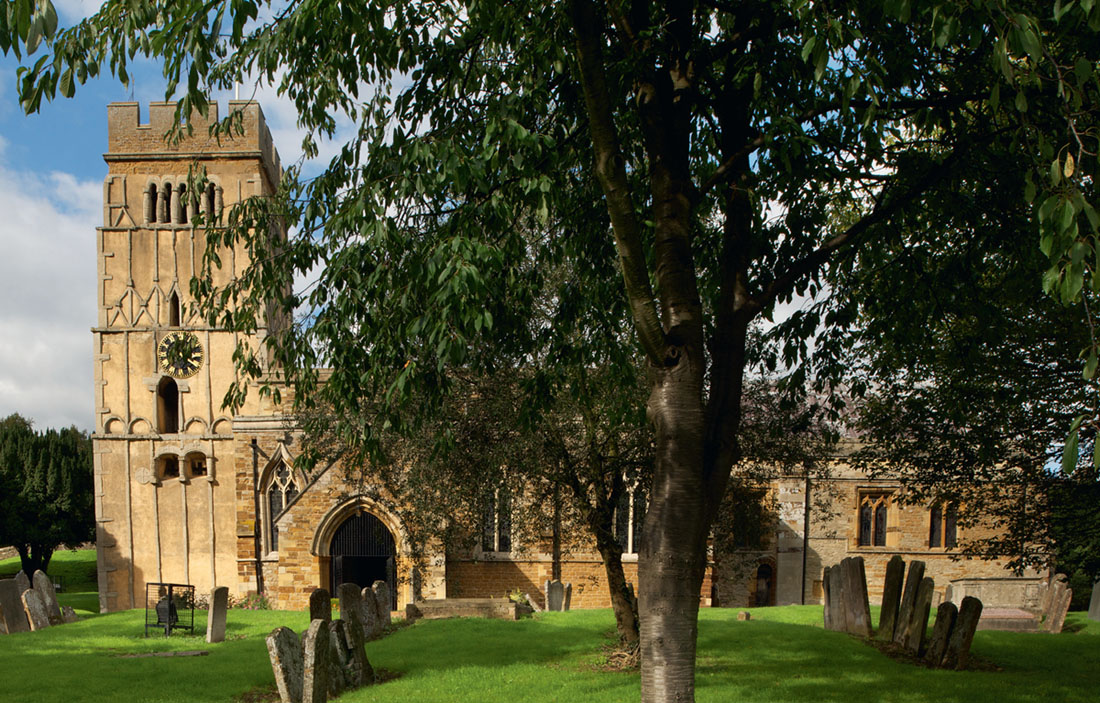
EARLS BARTON: ALL SAINTS – a rare surviving Saxon tower, with characteristic stripwork and crude arched bell openings in the top stage; the parapet above is later
© Michael Ellis
However, it is safer to try to imagine our parish church as it was in Norman times, as far more of our old churches are known to be Norman in origin than pre-Conquest, even though as in the church of Kilpeck (Herefordshire) the pre-Conquest style of decoration may have continued into Norman times. It is narrow and stone built. Let us suppose it divided into three parts. The small, eastward chancel is either square-ended or apsidal. Then comes the tower supported internally on round arches. The nave, west of the low tower, is longer than the chancel. The windows are small and high up. The church is almost like a fortress outside. And it is indeed a fortress of Christianity in a community where pagan memories and practices survive, where barons are like warring kings and monasteries are the centres of faith. These small village churches are like mission churches in a jungle clearing.
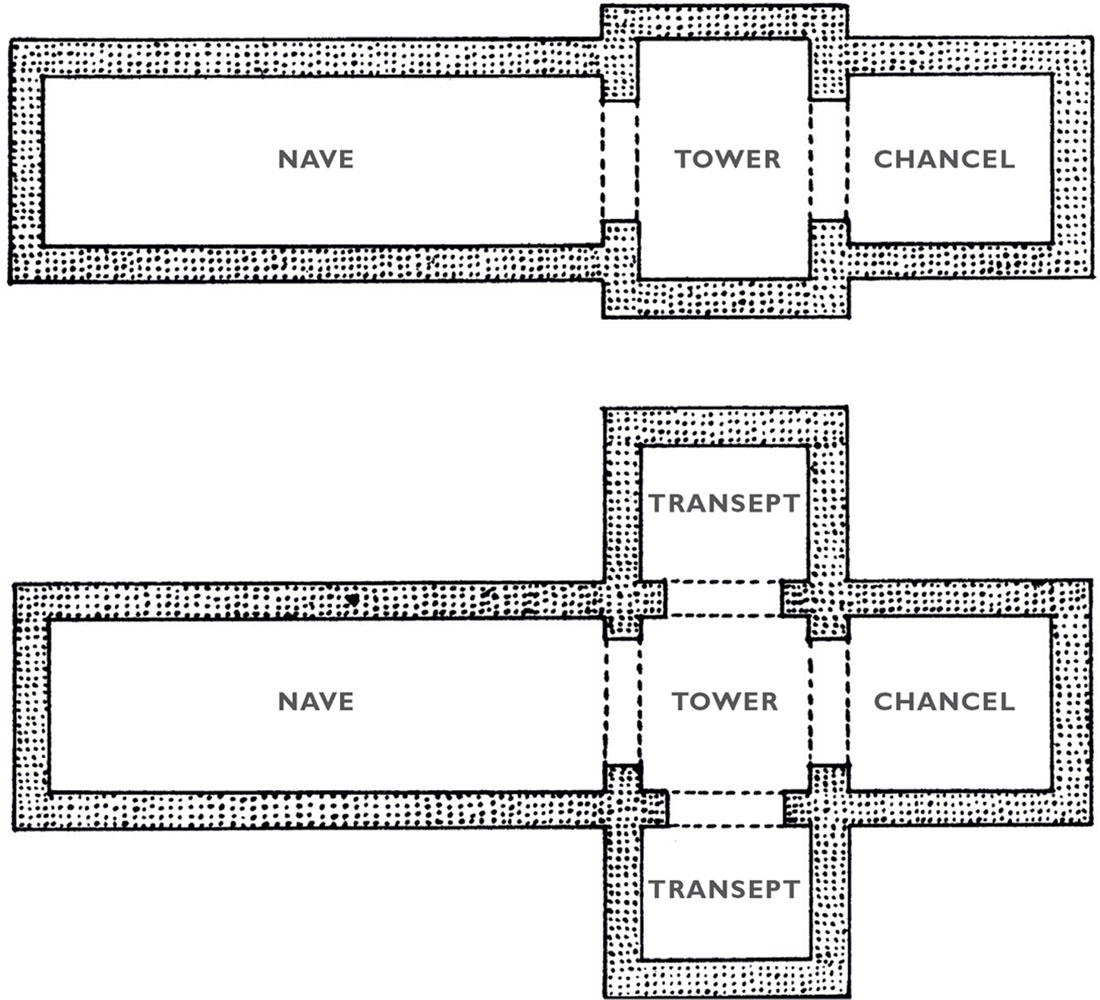
ANGLO-SAXON AND NORMAN – Two aisleless plans with central tower. (Top) tower between nave and chancel; (Bottom) tower over crossing of transepts with nave and chancel
There are no porches, and we enter the building by any of the three doors to the nave on the north, south or west. Inside, the walls of the nave are painted with red lines to look like blocks of stone. The raftered roof is hidden by a flat wooden ceiling which is painted with lozenges. The floor of the nave is paved with small blocks of stone or with red tiles. There are no pews. We can only see the chancel through a richly moulded round arch, that very arch which is now the South Door of your parish church. Above this chancel arch is a painted Doom, not quite so terrifying as that of the 15th-century church, for all the painting here is in the manner of the mosaics still seen in basilicas of Italy and eastern Europe.
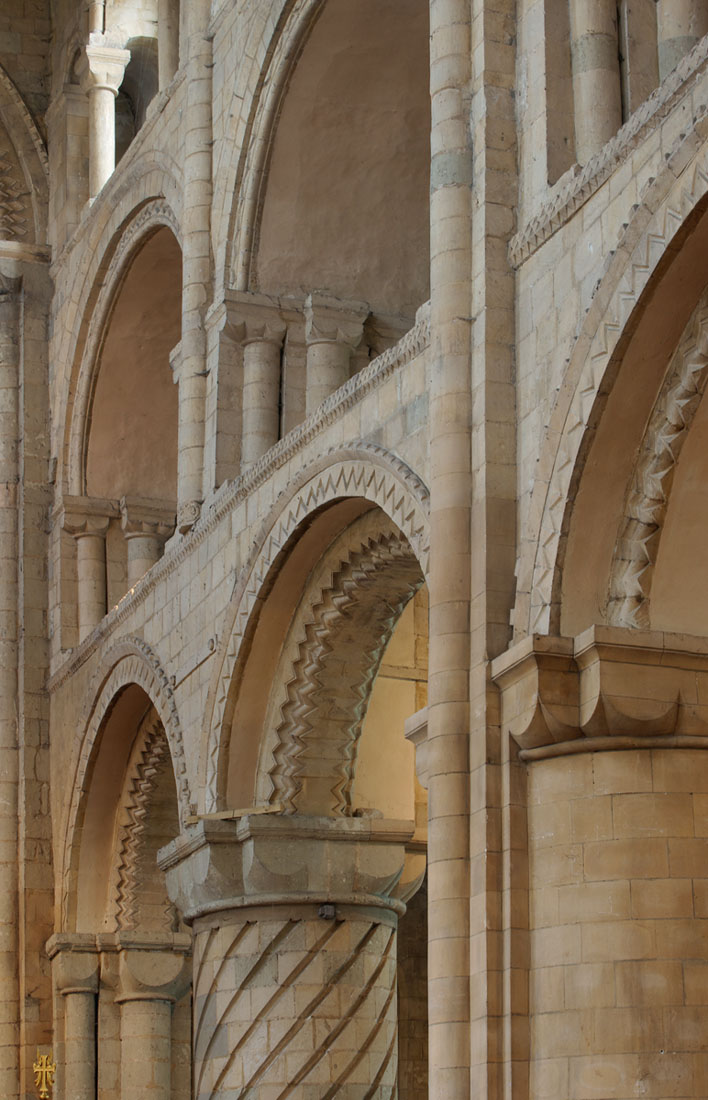
WALTHAM ABBEY: HOLY CROSS – sturdy Norman arcades sometimes survive in churches that have been much altered in later centuries, though not all are carved with as much grace as these very decorative columns for the abbey church
© Michael Ellis
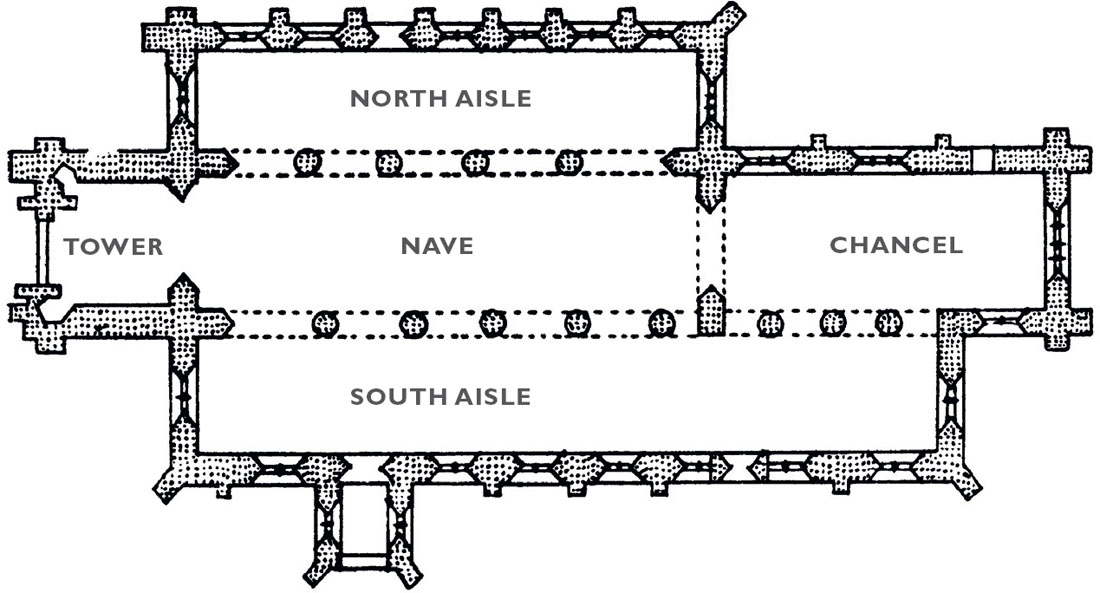
GOTHIC ADDITIONS TO A NORMAN PLAN – Based on Raunds, Northamptonshire: probably this was a Norman aisleless church consisting of nave and chancel of equal width. A tower and north aisle ot the nave were added in the 13th century. In the 14th century a south aisle was added. The original Norman walls were pierced and turned into arcades.

A TOWN CHURCH ENLARGED IN THE 13TH AND 14TH CENTURIES SO AS TO PROVIDE GUILD CHAPELS – Based on Grantham, Lincolnshire
The splays of the windows in the nave have figures of saints painted on them. But it is through the chancel that we see the greatest riches. Stained glass is rare. If there is any it is in the sanctuary and black with much leading and giving the impression of transparent mosaics. The walls are painted everywhere with figures, also recalling mosaic pictures. There are bands of classic style, patterns dividing them. The altar is of stone, small and box-like, recalling the tombs of Christians in the catacombs of Rome in the very earliest days of Christianity. The altar stands well away from the eastern, semi-circular end of the apse. It is covered with a cloth hanging over its four sides, decorated with vertical bands.
Our Lord is depicted on the cross as a King and Judge, not as a man in anguish as in later crucifixions. The religion of the time was less concerned with Him and Our Lady as human beings, more concerned with the facts of Judgement, Death and Hell. It was more ascetic and severe.
PART TWO: THE NEWER CHURCHES
Of the 16,000 parish churches in England more than half have been built since the 17th century, and the majority of these were erected in the 19th and 20th centuries. Guide books, almost wholly antiquarian in outlook, still dismiss even 18th-century churches as ‘modern’, while Victorian buildings are usually beneath their consideration. Yet some of the noblest churches are post-Reformation, from cathedrals like St Paul’s and Truro and Liverpool, to the great town churches designed by such architects as Hawksmoor, Gibbs, Street, Butterfield, Pearson, Brooks, Nicholson and Comper.
The first post-Reformation churches differed little in plan from those of medieval times. Wren in some of his churches for the City of London seems to have tried to build uncompartmented churches, where Baptism, Morning and Evening Prayer and Holy Communion could all be conducted in an undivided space, without the priest and his assistants moving out of sight and earshot.
Usually the plan was the nave with three-decker pulpit dominating for Matins, Litany and Evensong, a screen through which the congregation passed for Communion, and a Bapistry at the west end. The earliest post-Reformation churches usually had west galleries for organ and choir and also side galleries, because by the 17th century the population had begun to increase, especially in the towns where many new churches were built. The churches of the 17th and 18th centuries were mostly built on the English medieval plan. The only noticeable new feature in the more traditional churches was that the chancels were shallower and broader than those surviving from earlier times.
The style of tracery and decoration and wood-carving certainly changed. Windows were square-headed in the 16th century, and thereafter became round-headed. Grapes and cherubs and a cornucopia of fruit cascaded down the sides of altar-pieces, wreathed round the panelling of pulpits, and flattened themselves into patterns on the ceiling. The Renaissance style of Italy became the fashion. But it was an English version. Wren’s Portland stone steeples and lead spires, so happily clustering round St Paul’s Cathedral, are a recollection of Gothic architecture, though most of them are Renaissance in detail.
The interior of even the most room-like classic church of the 17th and early 18th centuries generally differs from its contemporary Dissenting interior. In the former there is provision for the expounding of the Word, and for the two chief sacraments; in the latter there is provision for the Word, but there is no suggestion of an altar about the table that is set for Communion. There may be some significance in the hour-glasses so often found beside the Anglican pulpits. They were intended as a check on the length of the sermon, and perhaps as a reminder to parson and people that there were other offices of the Church to be performed than preaching. Only for the short period when the Commonwealth ejected ordained priests of the Church, who returned with the Restoration, can these interiors have resembled Dissenting meeting houses.
Some of our finest scuplture is to be found in the monuments erected in all parish churches new or old during the 17th, 18th and early 19th centuries. A whole illustrated literature of this has been developed by the late Mrs Esdaile and Mr Rupert Gunnis. The work of great sculptors ignored or despised by the Victorians, such as Roubiliac, Rysbrack, Stone, Wilton, the Bacons, Hickey and Paty, has received recognition owing to their writings.
From the middle of the 18th century until its end, new churches were Classic, usually in the manner of the Brothers Adam, with chaste decorations in low relief in interior plaster and woodwork, and comparatively plain exteriors. The individuality of architects was beginning to assert itself over traditional plan and local styles. Cross-shaped churches were built with altar at the eastern axis and there were square and octagonal churches as well as proprietary chapels with the pews all arranged for a view of the occupier of the pulpit. These last buildings came as near to a Dissenting chapel as Anglicanism permitted.
Gothic never died. The style was driven by the Renaissance out of churches and houses into barns, farms and cottages. It was revived in a romantic form, suggesting Strawberry Hill (1733), even in the 17th century. And a slender case might be made for its never having died even in ecclesiastical building. There are Stuart churches which are Tudor Gothic, such as Low Ham in Somerset (1624), and Staunton Harold in Leicestershire (1653), which are like late Perpendicular medieval churches, and not a conscious revival but a continuance of the old style. St Martin-in-the-Fields, London, until its rebuilding by Gibbs in 1721, had been continuously rebuilt in the Gothic style since the time of Henry VIII. There are churches like St John’s, Leeds (1632), and Compton Wynyates (1663), which are a mixture of Classic and Tudor Gothic. Then there are the first conscious imitations of old forms by architects, such as Sir William Wilson’s tower of St Mary’s, Warwick (1694), and Wren’s tower and steeple to St Dunstan-in-the-East (1698), and his towers of St Mary Aldermary (1711) and St Michael’s Cornhill (1721). There is an interesting and well-illustrated chapter on this subject of the earlier revival of Gothic in M. Whiffen’s Stuart and Georgian Churches. The plan of these buildings was almost always traditional with an emphasized chancel. Now and then a Lutheran element crept in. In the Gothic church of Teigh in Rutland (1783), the small font is fixed by a brass bracket to the Communion rails. But the seats face north and south and the pulpit is at the west end.
In the reign of Queen Anne Parliament passed an act to remedy the insufficiency of accommodation for worship in London and the vicinity. Leading architects of the time like James Gibbs, Archer and Hawksmoor were employed, and several fine churches which challenge those of Wren were the result. Other large towns, for this was a time when the population of the midlands was rapidly expanding, followed London’s example.
Throughout the 18th century there was great interest in theology. Anyone looking through the library of a country house can verify this, for he will find rows of superbly bound volumes of sermons and controversial pamphlets and histories of religion. In the spas and the richer parts of London, private chapels were built for favourite clergy. They are well described by T. Francis Bumpus in London Churches, Ancient and Modern:
‘Well pewed, well warmed, undedicated, unendowed, unconsecrated, here captivating preachers of the Morphine Velvet, lavender-kid-glove school of theology dispensed the most comfortable doctrines. The pews were filled, and the good promoters were amply repaid by the pious tenantry, but accommodation for the poor was never thought of.’
Not all proprietary chapels were like this. Some were undoubtedly missions for teaching the Faith to the rich and indifferent or for bringing the Gospel to the poor. When town parishes grew very large in the 18th century, it was sometimes the custom for a chapel to be rented or built, and, if it did not succeed, to be sold again, or in some instances taken over by dissenters. St Martin-in-the-Fields had two such chapels which have now disappeared, and there were three in the parish of St Margaret Westminster and seven in the parish of St Pancras.
Few of these proprietary chapels survive as such today. Sometimes there is, in a large provincial town, one very Evangelical church, in classic style, whose patronage is in the hands of private trustees. This may well once have been an 18th-century proprietary foundation. In 1746 there were nineteen in London, excluding chapels belonging to Royal and Episcopal Palaces, Almshouses, Prisons, Livery Companies and Inns of Court. Those which have not been pulled down or become Dissenting places of worship, have been consecrated and turned into parish churches. I remember one in Bath called Kensington Chapel, which was Calvinistic yet Anglican, but which is now a furniture store. At another in Homerton, London, known as Ram’s Episcopal Chapel, I attended worship, and the clergyman wore a black gown and bands for preaching. This charming 18th-century chapel is now, alas, demolished. At Christ Church, North Brixton, London, is an extremely original and impressive episcopal chapel re-erected in 1904 in the Byzantine style from designs by Professor Beresford Pite. It was built privately and in it the black gown was still used in 1952.
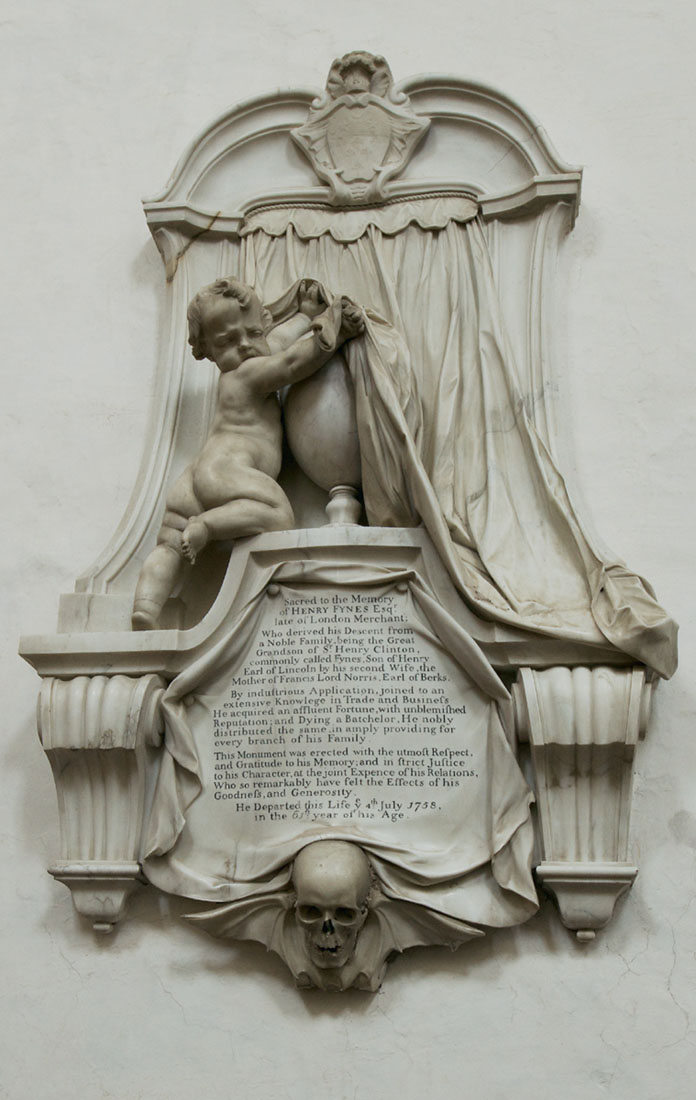
WING: ALL SAINTS – this monument was sculpted by Roubiliac, a French artist of the 18th century who worked mostly in England; his work fell out of fashion by the 19th century




